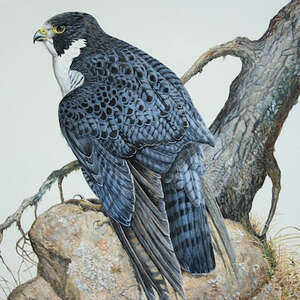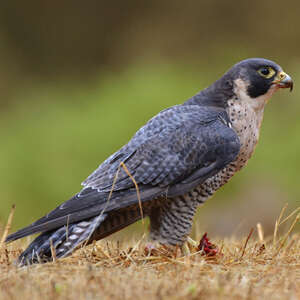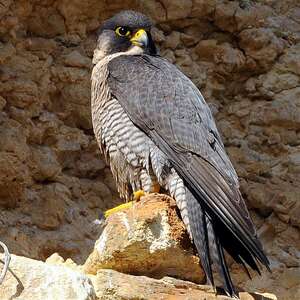Peregrine Falcon
Falco peregrinus - Faucon pèlerin
Identification
Perched, the Peregrine Falcon appears compact, shorter and relatively broader in shoulder than the Common Kestrel, and also significantly less voluminous. In fact, the female has the corpulence of a large Eurasian Collared Dove, while the male, 1/3 smaller (hence its name of tiercel) has that of a domestique pigeon. This term of tiercel is borrowed from falconry, it originally designates the male peregrine, exclusively, but for several decades it has been generalized to the male of all raptors.
The round head, relatively large compared to the body, appears relatively small in the female than in the male. It is black in the adult, darker or reddish brown in the young less than a year old.
The cheeks are marked with a large black patch in the shape of a beard called mustache. This - common to all varieties of falcons - is particularly wide in the peregrine; the black head and large mustache give the impression that the bird is helmeted.
The beak is curved, short and provided with denticulation on the upper jaw, which can be seen in all falcons. This kind of tooth would allow falcons to more easily kill their prey by cutting ligaments of the cervix and the spinal cord.
The plumage of the two sexes is substantially the same. However, the male is often lighter and bluish than the female, whose colors tend toward grayish anthracite more or less tinged with brown. In the female, the clear contrast at the base of the tail is less marked than in the tiercel. The underparts are chamois, dotted with brown tears in the young, white to reddish white and transversely barred with black in the adults. The male, more often than the female, has a uniform or lightly marked white throat, while that of the female is generally sprinkled with large black spots.At a distance, the male thus appears more contrasted - white and grey - on the underparts, unlike the female which appears more uniform, light or reddish, but more often reddish than the male. The back is a fairly uniform brown in juveniles, grey in adults. The fledging juvenile has the upper coverts fringed with buff. The wax on the beak, the eye ring and the legs are maize yellow in adults. In juveniles, the first two are blue. The legs are bluish or yellowish green, fading to dull yellow in the months following fledging.
Subspecific information 18 subspecies
- Falco peregrinus peregrinus (n Eurasia. s of tundra.)
- Falco peregrinus tundrius (Alaska to Greenland)
- Falco peregrinus pealei (Aleutians to s Alaska and sw Canada)
- Falco peregrinus anatum (North America. south of tundra. to n Mexico)
- Falco peregrinus cassini (w South America. Colombia to Tierra del Fuego. , Falkland Is.)
- Falco peregrinus calidus (Lapland to ne Siberia)
- Falco peregrinus japonensis (ne Siberia to Japan)
- Falco peregrinus brookei (Mediterranean region to Caucasus and n Iran)
- Falco peregrinus peregrinator (Pakistan, India and Sri Lanka to s and e China)
- Falco peregrinus furuitii (Bonin Is.. Japan.)
- Falco peregrinus madens (Cape Verde Is.)
- Falco peregrinus minor (Morocco, Mauritania, Africa south of the Sahara)
- Falco peregrinus radama (Madagascar and the Comoro Is.)
- Falco peregrinus ernesti (Philippines, Indonesia, New Guinea and Bismarck Arch.)
- Falco peregrinus macropus (Australia)
- Falco peregrinus nesiotes (Solomon Is, Vanuatu, New Caledonia, Fiji)
- Falco peregrinus babylonicus ()
- Falco peregrinus pelegrinoides (Canary Is., n Africa to Arabia and sw Iran)
Foreign names
- Faucon pèlerin,
- Halcón peregrino,
- falcão-peregrino,
- Wanderfalke,
- vándorsólyom,
- Slechtvalk,
- Falco pellegrino,
- pilgrimsfalk,
- Vandrefalk,
- sokol sťahovavý,
- sokol stěhovavý,
- Vandrefalk,
- muuttohaukka,
- Swerfvalk,
- falcó pelegrí,
- Förufálki,
- sokół wędrowny,
- lielais piekūns,
- sokol selec,
- Сапсан,
- Alap-alap kawah,
- ハヤブサ,
- 游隼,
- เหยี่ยวเพเรกริน,
- 遊隼,
Voice song and call
Outside of the nesting season, the Peregrine Falcon is usually silent. However, from mid-February to late-June (the breeding period) and particularly during courtship (February-March), it is very demonstrative and noisy. Perched in the breeding site, both the male and the female emit long and drawn-out calls that could constitute a song. In flight or perched on the nest or its surroundings, the falcons produce many brief and clicking vocalizations (the famous Tsicks) that indicate a high level of excitement, particularly when a conspecific approaches. If disturbed or threatened during the breeding period, the Peregrine Falcon sounds an alarm call: its alarm call is a powerful call made up of the repeated kré, kré, kré... rasped syllables.
Habitat
The Peregrine Falcon is a rock bird. It uses cliffs as both a high observation point for hunting as well as for nesting.
Behaviour character trait
The Peregrine Falcon is remarkable for its flying abilities. During the breeding season, the two partners engage in aerial games such as pursuits, dizzying dives, and spectacular loopings. During vertical dives from a very high altitude, its speed can exceed 350 km/h. The female, being heavier, can reach even higher speeds, although the smaller male gives the impression of being faster.
When hunting, the falcon follows either a gliding flight or a "placement flight", which can go on for several kilometers, closing its wings for the final attack. This "closed-wing dive" is usually performed at angles between 30 and 40-50 degrees below the horizon. During these assaults, the falling time with wings more or less attached to the body is not long enough for the speed to exceed 150 to 250 km/h. However, sometimes during vertical hunting dives over 1 km - very rarely observed - it has likely been known to exceed 350 km/h, as indicated by the measurements taken in a wind tunnel (Tucker and Cade) or on falcons released from an aircraft (Ken Franklin).
At the end of the dive, the trajectory is more or less horizontal or ascending, so that the prey is approached from behind in the blind spot of the tail.
The rate of success of attacks varies considerably from one region and one period of the year to another. The highest rates - approximately 1 catch for 5 to 10 attacks - are observed when attacking above bodies of water where there is no possible refuge for the prey. But generally, the capture rate is closer to one catch for 15 attacks, on average.
The couples are very attached to their territory, but it is mostly the males - the tiercels - who are the owners of the site and who defend it against intruders. The females, on the other hand, are less attached to the site and may, depending on the case, change sites and partners from one year to the next. On the other hand, because of their burly build, it is mainly the females who defend the site and the nest against intrusions of potential predators. Defensive attacks are usually accompanied by alarm cries, while territorial attacks towards another Peregrine Falcon are accompanied by loud and repeated tsicks. Whether territorial or defensive, when the two partners are present in the site, they both participate in the attacks, the tiercel being the most aggressive towards another tiercel and staying in the background when it comes to interspecific defensive attack.
Flight
In a gliding flight, the Peregrine Falcon's wings are bent backwards (like a scythe blade) and appear to be pointed.
Its wingbeats are swift - 5 to 6 per second - and of low amplitude when it is performing a normal flight. This flight is interspersed by short glides. Conversely, when it is performing an attack flight, its wingbeats - still swift - have a much greater amplitude and accelerate until the Peregrine Falcon closes its wings for the terminal dive.When gliding, if the wind is strong enough, the wings are bent backwards, its tail nearly closed; the bird then takes up the shape of a large swallow, or, as Paul Géroudet would say, the form of a ship's anchor. On the other hand, if the wind is less strong, the tail is spread out like a fan and the wings nearly straight and horizontally to the back, the bird then takes the shape of a cross. With heavier, 'denser' female Peregrine Falcons, the tip of the wing usually forms an angle pointing up from the wrist.
Dietfeeding habits
It is not possible to give a precise diet, as this varies considerably from one region and time of year to the next.
An ornithophage, the Peregrine Falcon hunts almost exclusively birds captured in flight. However, like many other falcons, it does occasionally capture large insects in flight - for example bumblebees - or bats, and anecdotally, rodents.The smaller males feed on prey ranging in size from a tit to a jay, or even a rock dove. The larger females take prey ranging in size from a blackbird to a woodpigeon, rarely larger. Reports of the capture of ducks or even geese and herons have been made, but these are highly exceptional and refer to northern birds - more robust - during their migration, thus not needing to bring back to the cliff the prey which is eaten on the spot. These exceptional prey highlighted often give a false idea of the Peregrine Falcon's actual diet, overestimating their hunting capabilities.
Reproduction nesting
In France, the nesting of Peregrine Falcon pairs starts with the first nice days of February (sometimes mid-January), and peaks at the beginning of March. The mating starts about 2 to 3 weeks before laying. As with the nocturnal species, Falcons do not build nests. They lay eggs on the ground on a ledge, in a hole, a niche, or an old nest of large crows or other raptors. The sandy or earthy substrate covering the ground is scraped by one or the other of the two adults. In a cliff, several locations are scraped by both the male and the female, but it is up to the female to choose to lay in one or the other of the scrape cups that will become the nesting site.
Laying consists of 3 to 4 eggs, more rarely 2 or 5 (up to 6 exceptionally, only 2 known cases). The eggs, reddish brown in color, are laid every 48 to 72 hours. If the laying is destroyed in the first days of incubation, a replacement laying can start 15 days later (capacity which has been exploited in the Peregrine Project, initiated in 1974 in the Jura to increase the natural productivity of the Peregrine Falcon population, decimated by contamination with organochlorides and desairages).
In the few days before laying, the female's belly is swollen and the bird hardly flies anymore, she is fed by the tercel.
Incubation takes 30 days, it is ensured, roughly, for two thirds of the time by the female and for one third by the male. It begins with the laying of the penultimate egg (generally the third) so that the chicks hatch almost on the same day, with 24 hours' difference. At hatching, the chicks are covered with a first soft white down, which will be replaced by the second down, much denser and thicker, from the 15th day.In their first week, there is no difference in size between males and females.
Breeding: If weather conditions are good, the female does not leave her young during the first week. She remains with them to keep them warm, more or less lying down and getting more upright as the days pass. If all goes according to plan, the male hunts and brings prey back to the nest site. The female is the one who processes and distributes the food, but the male is perfectly capable of doing this task when the female lets him.
By the 15th day, the young ones are covered with the second down, and are completely covered in it by the 20th day. This very dense and thick down allows the Peregrine Falcons to resist the lower temperatures on their own. The female then leaves them alone more and more often and for longer periods of time, all the while staying nearby to protect them if necessary, as long as the male does his job in providing prey. If, for some reason - a bad hunter third-bird, laziness, adverse weather conditions - the female may leave the site and go hunting herself. The nest left without protection is then open to other predators, like the Common Raven, among others.
It has been observed that sometimes a second female, generally an immature, is accepted by the breeding couple and participates in incubation as well as feeding the young.
Geographic range
The Peregrine Falcon is cosmopolitan and can be found in all parts of the world, except in regions with very low or very high humidity (dry and cold deserts of the Arctic, dry and hot deserts of the Sahara Goby or Central Australia). In these regions of low humidity, it is replaced by desert falcons - the hierofalcons (Gyrfalcons, Sacred Falcons, Lanier Falcons, Laggar Falcons, Brown Falcons, Prairie Falcons). In the tropical humid forests and New Zealand, its ecological niche is filled by neighboring species that are better adapted to these particular climatic conditions (Orange-breasted Falcons in the Amazon, Taita in Equatorial Africa or New Zealand Falcons).
Threats - protection
IUCN conservation status
concern
in the Wild
threatened
evaluated
In the 1960s, the massive use of organochlorine pesticides in agriculture - DDT, Heptachlor, Lindane, etc. - led to a spectacular decline in the species in most regions of the world. In France, the Peregrine Falcon only survived in the less polluted mountainous regions - Jura, Alps, southern Massif Central, Pyrenees, Corsica.
Nowadays, the collection of eggs and young birds for their use and sale has practically disappeared thanks to the ban on organochlorine pesticides and reproduction of raptors in captivity to meet the demand.
Today, the greatest threat is the invasion of traditional nesting sites by sports-related tourist activities - climbing, free flying, etc. Once inaccessible, the most remarkable sites, precisely those that enabled the species to escape eradication, have become the playground of city dwellers in search of nature or thrills.
Furthermore, the accelerated expansion of populations of Eurasian Eagle-Owls is a worsening natural factor. Pairs confined to the area, disturbed by the presence of the great night owl, abandon the egg laying process and disappear from the site, either in an attempt to escape from predation or because they have fallen under its claws.
This situation would not be catastrophic - the eagle-owl and the peregrine have coexisted for millennia - if the peregrines still had historic refuges to escape predation. Unfortunately, these historic refuges are often now sterilized by uncontrolled outdoor activities.
Sources of information
- IOC World Bird List (v15.1), Gill, F and D Donsker (Eds). 2025-12-07.
- Revue Alauda n° 42, S.E.O.F.
- Revue Alauda n° 51, S.E.O.F.
- Peregrine Falcon Populations: Their Management and Recovery, Tom J. Cade, James H. Enderson
- 2de Peregrine Conference Poland 2007 Piotrowo, Janusz Sielicki
- Revue Alauda n° 76, S.E.O.F.
- Hydrodynamic drag of diving birds: effects of body size, body shape and feathers at steady speeds, J.R. LOVVORN, G.A. LIGGINS, M.H. BORSTAD, S.M. CALISAL and J. MIKKELSEN
- Revue Alauda Vol. XLI, n°4-1973, 403-412, Monneret R.J.
- Le faucon pèlerin, René-Jean Monneret
- Gliding birds: the effect of variable wing span. J. Exp. Biol. 133, 33–58., V.A. TUCKER
- Revue Alauda n° 38, 186-190, J.F. Terrasse
- Gliding flight: speed and acceleration of ideal falcons during diving and pull out. J. Exp. Biol. 201, 403–414., V.A. TUCKER
- Gliding flight: drag and torque of a hawk and a falcon with straight and turned heads, and a lower value for the parasite drag coefficient. J. Exp. Bi, V.A. TUCKER
- Curved flight paths and sideways vision in pérégrine falcons (Falco peregrinus). J. Exp. Biol. 203, 3755–3763., V.A. Tucker, A.E. Tucker, K. Akers and J.H. Enderson
- An optical tracking device for recording threedimensional paths of flying birds. Rev. Scient. Instr. 66, 3042–3047., V.A. TUCKER
- The deep fovea, sideways vision and spiral flight paths in raptors. J. Exp. Biol. 203, 3745–3754., V.A. Tucker
- The peregrine fund, Conserving Birds of Prey Worldwide
- The Birds of North America,
- Courbe brachistochrome, R. Ferréol, J. Mandonnet
Other sources of interest
 Specification sheet created on
29/07/2023 by René-Jean Monneret
Specification sheet created on
29/07/2023 by René-Jean MonneretTranslation by AI Oiseaux.net
© 1996-2025 Oiseaux.net
- Accipitriformes
- Aegotheliformes
- Anseriformes
- Apodiformes
- Apterygiformes
- Bucerotiformes
- Caprimulgiformes
- Cariamiformes
- Casuariiformes
- Charadriiformes
- Ciconiiformes
- Coliiformes
- Columbiformes
- Coraciiformes
- Cuculiformes
- Eurypygiformes
- Falconiformes
- Galliformes
- Gaviiformes
- Gruiformes
- Leptosomiformes
- Mesitornithiformes
- Musophagiformes
- Nyctibiiformes
- Opisthocomiformes
- Otidiformes
- Passeriformes
- Pelecaniformes
- Phaethontiformes
- Phoenicopteriformes
- Piciformes
- Podargiformes
- Podicipediformes
- Procellariiformes
- Psittaciformes
- Pterocliformes
- Rheiformes
- Sphenisciformes
- Steatornithiformes
- Strigiformes
- Struthioniformes
- Suliformes
- Tinamiformes
- Trogoniformes


































